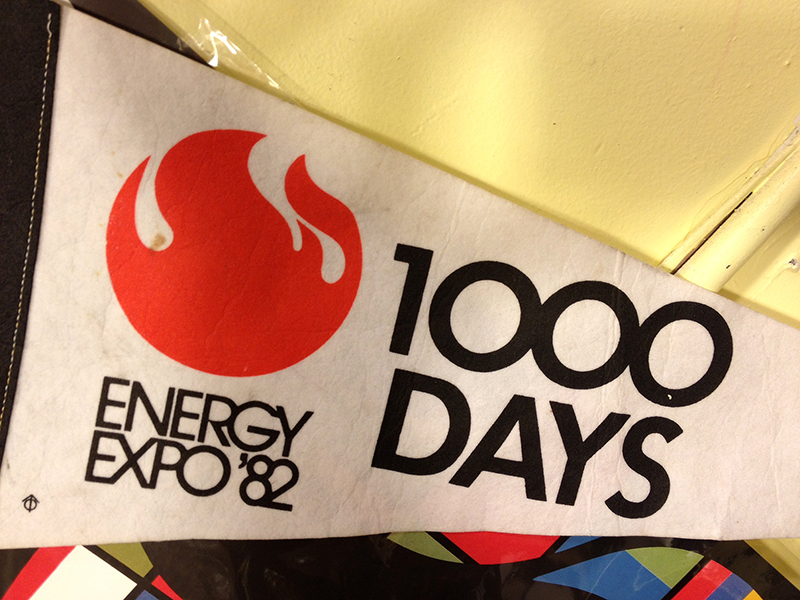By many accounts, the most popular exhibits at the 1982 World’s Fair in Knoxville were the displays of ancient artifacts, like China’s 2,200-year-old terracotta warrior statues, or futuristic inventions, like Japan’s picture-painting robotic arm. Attendees also fondly recall the German beer hall, the Korean dancers, Tennessee bluegrass concerts, and President Ronald Reagan’s opening speech.
With such exotic offerings and rare opportunities, it’s easy to forget that the fair had an official theme, “Energy Turns the World.” In fact, nearly all of the fair’s participants staged displays showing the future development of their energy industries, whether through solar panel development, an expansion of nuclear power, oil exploration, or other means.
In hindsight, these displays provide an interesting look at how the world of thirty years ago—one that had a fresh memory of the oil crises of the 1970s and the Three Mile Island nuclear accident, but had not yet experienced Chernobyl, climate change, or the Middle Eastern conflicts of the early twenty-first century—believed the future would evolve. Some countries stayed fairly close to the path they laid out, others ended up far away, and a few ended up circling around to land fairly close to their starting point of three decades ago. Here’s a look at how several countries’ predictions panned out.
China
The Chinese pavilion touted the emerging country’s solar power developments. In the decades following the fair, however, China largely turned away from solar power to focus on coal as an energy source; in fact, a report by the US Energy Information Administration stated that China’s coal use doubled from 1980 to 2000, and then doubled again between 2002 and 2007. 1 But China has made a remarkable investment in clean energy in the past few years, and in 2009 it surpassed the United States as the number one nation for installed clean energy capacity. The largest sector of growth was in wind power, which received 72 percent of clean energy investment, compared with solar power, which received 6.3 percent.2
Germany
At the time of the fair, Germany was split into two countries, and only the Federal Republic of Germany (West Germany) attended the event. Germany’s exhibit emphasized the country’s developments in solar, wind, and nuclear energy. For the past three decades nuclear power has been an important power source for Germany, but growing antinuclear sentiment among the German population and the Fukushima meltdown in Japan last year prompted the German government to reverse its policies and accelerate its plans to phase out the country’s nuclear power plants.
Although Germany continues to invest heavily in wind and solar power technologies—the government hopes that by 2020, 35 percent of the country’s total power consumption will come from renewable energy sources—the hastened phaseout of the country’s nuclear power plants means Germany will need to find alternative means of meeting its short-term energy needs. Recently, the country has turned to coal as a way to solve the problem, and while renewable energy development is still a large priority, rapidly rising costs for solar and other technologies, as well as unpredictable electricity generation rates from renewable sources, have cast some doubts as to whether Germany can achieve its goals.3
Saudi Arabia
Saudi Arabia’s pavilion tried to dispel the country’s stereotypical image as a sandy stretch of oil wells by promoting its solar energy developments. Three decades later, however, Saudi Arabia is still largely dependent on oil, which fuels 50 percent of the country’s electricity production (and accounts for more than 80 percent of its revenues). Last month, the Saudi government announced it is seeking investors to build a massive renewable energy plant, which would feature solar power as a main component. Saudi Arabia hopes that by 2032, solar power will provide up to a third of the country’s domestic energy needs.4
Mexico
Mexico touted its growing oil exportation industry, which did flourish in the two decades following the fair. Mexico is one of the largest suppliers of oil to the United States, but production has dropped off sharply in the past few years. The state-owned agency Pemex has a monopoly on oil production and distribution in Mexico, and rules limiting foreign involvement in the industry have led to financial problems that hamper its ability to keep pace with technological advancements and growing domestic demand. Some experts believe that the country will switch from being an oil exporter to an importer within the next decade.5
References
1. Black. “Global warming lull down to China’s coal growth.” BBC News. July 5, 2011. Available at http://www.bbc.co.uk/news/science-environment-14002264.
2. The Pew Charitable Trusts. Who’s Winning the Clean Energy Race? 2010 Edition. March 29, 2011. Available at http://www.pewenvironment.org/uploadedFiles/PEG/Publications/Report/G-20Report-LOWRes-FINAL.pdf.
3. Birnbaum. Germany faces energy balancing act. Washington Post. August 23, 2012. Available at http://www.washingtonpost.com/world/europe/germany-faces-energy-balancing-act/2012/08/23/d3b82ddc-e979-11e1-936a-b801f1abab19_story.html.
4. Stewart. Saudi Arabia embarks on massive projects in Mecca and Medina. Independent. September 27, 2012. Available at http://www.independent.co.uk/news/world/middle-east/saudi-arabia-embarks-on-massive-projects-in-mecca-and-medina-8180630.html.
5. Collins Rudolf. Mexico oil exports could end within next decade, report warns. New York Times. April 29, 2011. Available at http://green.blogs.nytimes.com/2011/04/29/mexico-oil-exports-could-end-within-decade-report-warns/.

